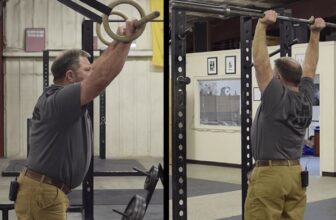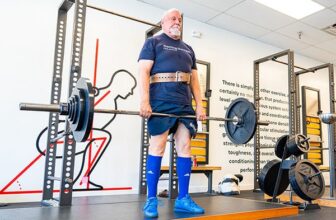
[adinserter block=”2″]
Gaining muscle is a common fitness goal for many people. It means wanting to increase muscle mass throughout the body through a combination of good strength training and nutrition. Rather than just doing the work though, it’s also ideal to track your progress so that you can determine whether what you’re doing is working or not.
There are several ways to tell if you’re actually gaining muscle. Some ways are performance-based, others are appearance-based or you can take the guesswork out of the equation and use proven methods such as with photos, the tape measure and bioimpedance scales—all while avoiding the regular scale.
We spoke to Ryan Hopkins, personal training manager of SoHo Strength Lab, to talk about his expert opinion on how to tell if you’re actually gaining muscle and how much muscle growth one can realistically expect.
How much muscle can I gain in a month?
Building muscle is progress. Unfortunately, it doesn’t happen overnight. Hopkins states, “This answer will depend on many factors such as biological age, sex, dietary habits, sleep habits, etc.” Your training program also contributes to how much muscle you can build, not to mention how long you’ve been training for.
If you’re a beginner at training, then you’re in luck. Beginners can typically make faster muscle gains than those who’ve been training for much longer. This is because those who are new to lifting and strength training are just starting the hypertrophy cycle, that is, when the muscle cells increase and grow due to an external force. Novice trainers can typically put on 1-4 lbs or approximately 1.5-1.8 kg of muscle a month.
Unfortunately, these beginners gains do drop off over time so you’ll build muscle but at a slower rate. However, “one can realistically gain 1 lbs of muscle in a month,” he says. “Visually this will not look like much because it will be spread out over the entire skeleton but this is, infact, significant muscular gain for most trainees.”
Optimize your muscle growth
If you want to maximize your muscle growth, then you put in effort both in the gym and with your nutrition. “The best thing you can do in your quest to gain muscle is to consistently strength train and undergo moderate amounts of physical stress,” says Hopkins. When it comes to your nutrition, he emphasises the importance of “maintaining a protein/ carbohydrate consumption that leaves you in a slight surplus for your daily energy demand.”
Focusing on both your training and nutrition and ensuring you remain consistent with your efforts can really set you up for success when it comes to muscle growth.
Ways to tell you’re gaining muscle
If building muscle is your fitness goal, then you may want to track your gains. This way, you can tell if you should continue with the training and nutritional choices you’re currently making or if you need to make adjustments to further your progress. Here are some ways to tell that you’re gaining muscle.
You’ve became stronger
One way to tell that you’re building muscle is if your strength increases. Typically, strength gains parallel with muscle gains so if you’ve noticed that you’ve become stronger, then that is a good indication that your muscles have grown.
Record your workouts so you can track your progress. Write down the exercises you do as well as how many sets and reps you complete and the weight that you use. Then, aim to slowly increase this over time so that you can build strength by either adding more sets or reps, upping the weight or shortening the rest time.
Your clothes fit differently
With your change in body composition, the way your clothes will fit on you will start to differ. They might become more fitted in the areas in which your muscles have grown, typically your hip and thigh area, and shoulders, chest and biceps. If you start to fill out your clothes a bit more in the places you want to fill out, then that’s a good sign.
You can see a visual difference
Taking weekly photos is a really good method of tracking your gains. It means that you can have a visual comparison between before and after shots so that you can have a clearer view of where you’re gaining muscle and other changes in your body.
The key, however, is to be consistent with your photos. Try and take them at the same day and time each week to minimize any variables which may account for differences in your shots. An ideal time is after you use the bathroom in the morning and before you exercise or consume any food and water. If you can as well, get them in the same lighting. Take them in from at least 3 different angles—font, side and back—so you can see your entire body.
Just remember though, you may not see a difference week by week, even with a visual aid. Building muscle is a slow and steady process so give yourself more time. Try and compare week 1 and week 12 photos, for example, as opposed to week 1 and week 2.
Your measurements have grown
Apart from taking photos, taking measurements is a surefire way to assess your muscle growth. Using the good ol’ tape measurement method, you can see the actual results from your efforts by measuring each individual bicep, forearm, quad and calf. You can also do your chest, shoulders, waist, hips and neck.
Likewise with the photos, take the measurements weekly, at the same time and day. Also, make sure you measure in the same place on your body each time, otherwise, a changed placement of the tape could mean inaccurate results.
The scale tells you
If you want to track your muscle gains, then take the guesswork out of it. “The best way is to regularly use a bioimpedance scale (inBody or similar unit),” comments Hopkins. “This will be much more specific in what it is measuring and you can be more certain of what you are gaining and losing.”
It’s a much more reliable way of tracking your muscle progress, especially when compared to other methods such as the scale. Hopkin comments, “A regular scale cannot tell you whether or not you have gained muscle mass.” This is because it takes into account everything that’s put on it and can’t differentiate between everything in your body including muscle, fat, water, internal organs and so forth.
However, “What it can do is give you a measure of your fluctuations in weight,” says Hopkins, “and if all other things remain constant (body fat %, hydration level,etc), it can indicate lean muscle growth.”
Final Note
Building muscle takes time. Being consistent with your strength training and nutrition are important but so is tracking your results. By assessing your progress either through visual aids or measurements and scales, to ensure you’re in the right direction, you’ll be able to fuel your muscle growth.
[adinserter block=”2″]
Credit : Source Post






